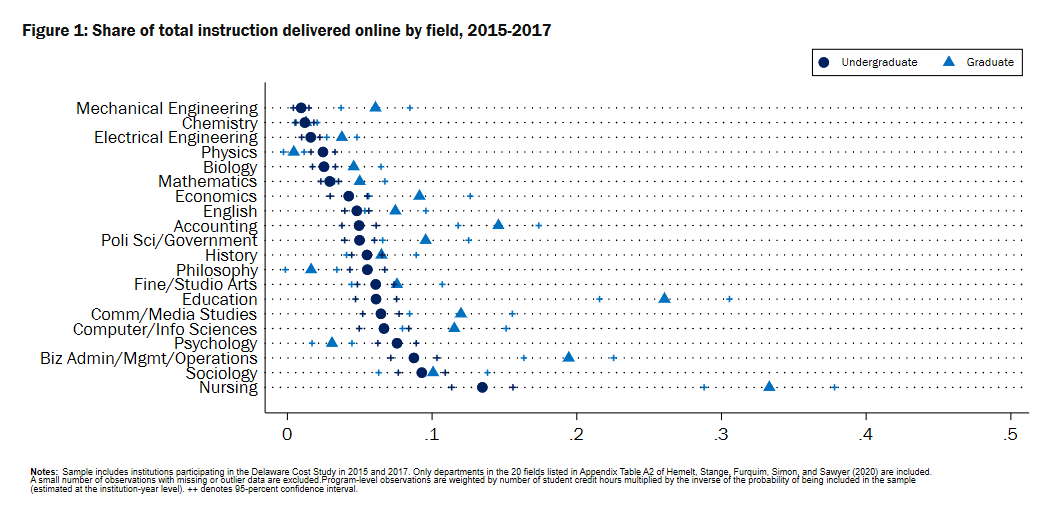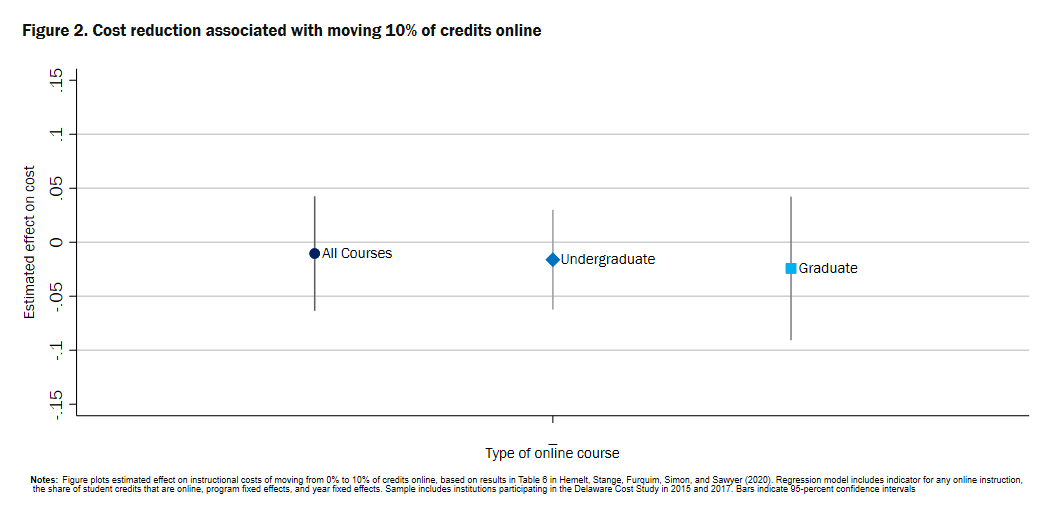As COVID-19 swept across the country in March, colleges shuttered and millions of students and instructors were propelled into a world of distance education. Institutional leaders are now grappling with how to provide a quality education over the academic year ahead while also guarding the health and safety of students, faculty, and staff. Online instruction is a core component of many colleges’ strategies, with a growing number abandoning in-person plans for the fall. Questions about the feasibility, quality, equity, and costs of online instruction sit front and center. Our recent analysis suggests that the difficulty of shifting instruction online is likely to vary across fields of study, and that movement to online education is unlikely to reduce instructional costs.
Students have rightly lamented the loss of face-to-face interaction with professors and access to on-campus facilities. Ample evidence suggests that students are less successful in online formats, especially students who are least prepared, and even in formats that blend online instruction with in-person support. Some students have called for tuition refunds due to perceived cost savings and lower quality of online instruction. At the same time, colleges face extraordinary budget woes from lost state and tuition revenue and increased need for student aid. If online instruction produced substantial cost savings, this would give institutions a bit more wiggle room to confront such challenges.
Evidence on the relationship between online coursework and costs is sparse; institution-level correlations suggest more online instruction is associated with lower sticker prices charged to students. Moreover, evidence on how online instruction differs by program and field is largely nonexistent. Although about one-third of all college students reported taking at least one course online prior to the pandemic, the feasibility and costs of delivering instructional content online are likely to differ by field. Hands-on activities in the lab-based sciences and performance arts may be especially hard to transform into online substitutes. Even fields poised to swiftly re-imagine instruction in a virtual world may struggle to replicate the multitude of in-person exchanges between peers and instructors that occur within and outside the walls of a classroom to produce engaged learning.
As part of a recently published descriptive study of postsecondary instructional costs, we analyzed the use of online instruction for over 3,000 individual departments at more than 200 different four-year institutions. We used data from 2015 to 2017 to explore the prevalence of online credits by field of study as well the association between online instruction and costs at a departmental level. Our work relies on novel, department-level data on credits and expenditures from a large and diverse sample of four-year institutions.
While the shift to online instruction during the pandemic is unparalleled in swiftness and scale, recent pre-COVID patterns might provide insight into the types of courses that colleges can transform into online versions most easily as well as the resulting cost implications.
Which fields were online?
Figure 1 shows the proportion of total credits delivered online by discipline, separately for undergraduate and graduate instruction. We highlight 20 common fields found at many institutions. The prevalence of online instruction varied dramatically, ranging from essentially zero for undergraduate engineering to almost a third of all graduate nursing credits. In our sample, the average share of credits offered online was a modest 6%. Online offerings, as well as exclusively online programs, were more common in graduate education than undergraduate. Private institutions and those with larger shares of tenure-track faculty also had less online enrollment. Across both undergraduate and graduate levels, many of the science and engineering fields reported low levels of online offerings, whereas fields such as business, computer science, and communications reported higher levels of online coursework. Fields that already have a substantial online presence–whether due to demand or supply factors–are likely to navigate the shift to additional online instruction more easily.

Will online instruction lower costs over the short run?
Based on our analysis, the short answer is, surprisingly, no. Simply moving more instruction online does not fundamentally alter the cost equation. We look at many departments over time and associate changes in online offerings with changes in average instructional cost per student. We find a negligible association between online credits and instructional costs, as shown in Figure 2. Shifting online instruction from zero to 10% of credits is associated with about a 1.04% reduction in departmental instructional costs, which we cannot statistically distinguish from no effect. Patterns are similar for undergraduate and graduate education.

Why is the association so small? Some believe online coursework will lower costs by reducing per-student labor costs via larger classes. However, there is debate about the appropriate size for online courses relative to traditional in-person classes, with some institutions imposing lower enrollment caps for online classes due to quality concerns. In our sample, we find that small, short-run cost savings on average salaries are offset by smaller classes and an uptick in non-personnel expenditures, resulting in little net change in instructional costs. It turns out that large lectures with standardized grading are a fairly cost-effective way of delivering instruction.
Our analysis examines incremental, short-term changes pre-COVID and omits some costs shared across departments, such as facilities and some computer hardware and software costs. Including these factors could either magnify or mitigate the long-term cost consequences of sustained, large-scale movement to online instruction.
Implications for educational leaders and policymakers
We see at least three takeaways for educational leaders and policymakers. First, this evidence suggests that recent (and ongoing) increases in online coursework are unlikely to lead to substantial cost savings for institutions. Looming cuts for public institutions from shattered state budgets combined with lower tuition revenue suggest that substantial federal support for students and institutions will be needed to help weather this crisis.
Second, given recent research that finds online or blended coursework is not as effective as face-to-face instruction, especially for students from underserved backgrounds and those struggling academically, universities need to offer additional supports (e.g., tutoring, mentoring, mental health services)–especially when students start to return to campus. These additional supports will likely make online instruction even more costly.
Third, the creativity of educators and students made possible continued access to learning for many this past spring; however, the crisis has also highlighted deep inequities in online access and supplementary supports, as well as facets of education that cannot be easily recast into an online format. National and state leaders need to prioritize creating the public health conditions that would enable institutions to safely return to high-quality, in-person postsecondary instruction as soon as possible.







Commentary
Why the move to online instruction won’t reduce college costs
July 28, 2020